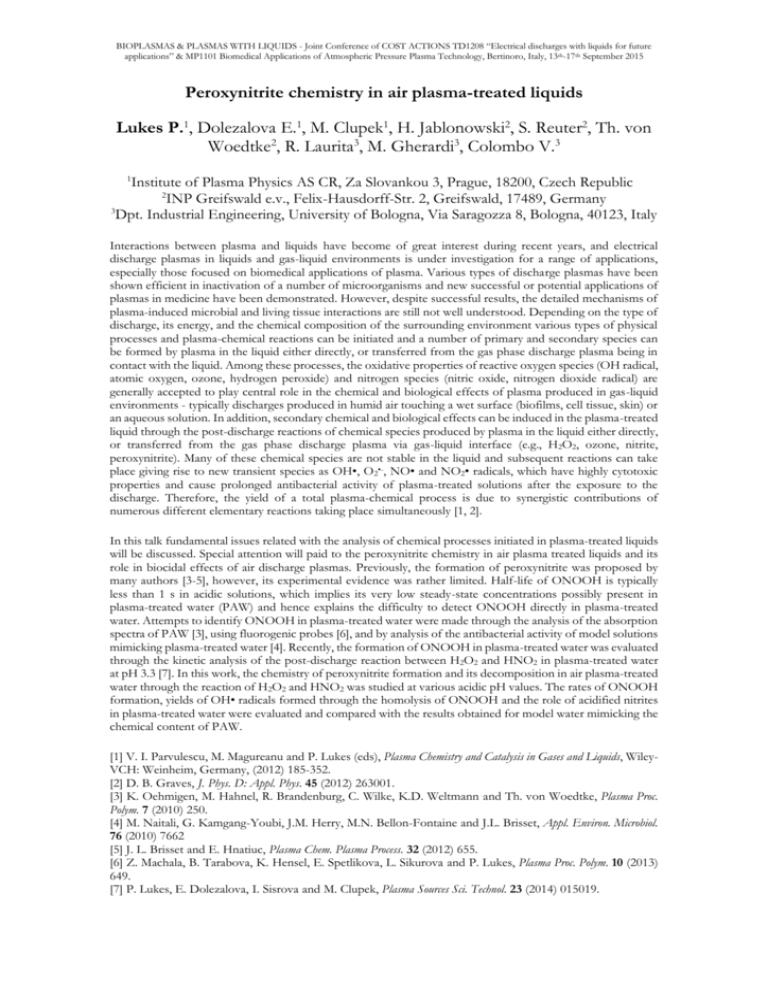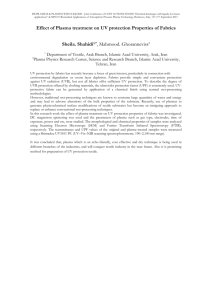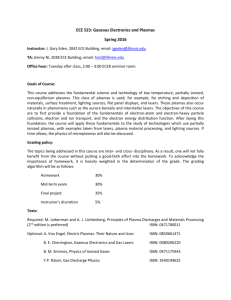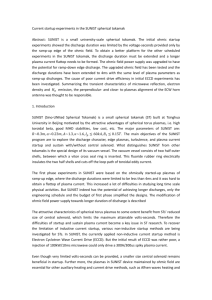Lukes-COST-Bertinoro-2015 - Bioplasmas and Plasmas with
advertisement

BIOPLASMAS & PLASMAS WITH LIQUIDS - Joint Conference of COST ACTIONS TD1208 “Electrical discharges with liquids for future applications” & MP1101 Biomedical Applications of Atmospheric Pressure Plasma Technology, Bertinoro, Italy, 13th-17th September 2015 Peroxynitrite chemistry in air plasma-treated liquids Lukes P.1, Dolezalova E.1, M. Clupek1, H. Jablonowski2, S. Reuter2, Th. von Woedtke2, R. Laurita3, M. Gherardi3, Colombo V.3 1 Institute of Plasma Physics AS CR, Za Slovankou 3, Prague, 18200, Czech Republic 2 INP Greifswald e.v., Felix-Hausdorff-Str. 2, Greifswald, 17489, Germany 3 Dpt. Industrial Engineering, University of Bologna, Via Saragozza 8, Bologna, 40123, Italy Interactions between plasma and liquids have become of great interest during recent years, and electrical discharge plasmas in liquids and gas-liquid environments is under investigation for a range of applications, especially those focused on biomedical applications of plasma. Various types of discharge plasmas have been shown efficient in inactivation of a number of microorganisms and new successful or potential applications of plasmas in medicine have been demonstrated. However, despite successful results, the detailed mechanisms of plasma-induced microbial and living tissue interactions are still not well understood. Depending on the type of discharge, its energy, and the chemical composition of the surrounding environment various types of physical processes and plasma-chemical reactions can be initiated and a number of primary and secondary species can be formed by plasma in the liquid either directly, or transferred from the gas phase discharge plasma being in contact with the liquid. Among these processes, the oxidative properties of reactive oxygen species (OH radical, atomic oxygen, ozone, hydrogen peroxide) and nitrogen species (nitric oxide, nitrogen dioxide radical) are generally accepted to play central role in the chemical and biological effects of plasma produced in gas-liquid environments - typically discharges produced in humid air touching a wet surface (biofilms, cell tissue, skin) or an aqueous solution. In addition, secondary chemical and biological effects can be induced in the plasma-treated liquid through the post-discharge reactions of chemical species produced by plasma in the liquid either directly, or transferred from the gas phase discharge plasma via gas-liquid interface (e.g., H2O2, ozone, nitrite, peroxynitrite). Many of these chemical species are not stable in the liquid and subsequent reactions can take place giving rise to new transient species as OH•, O2•-, NO• and NO2• radicals, which have highly cytotoxic properties and cause prolonged antibacterial activity of plasma-treated solutions after the exposure to the discharge. Therefore, the yield of a total plasma-chemical process is due to synergistic contributions of numerous different elementary reactions taking place simultaneously [1, 2]. In this talk fundamental issues related with the analysis of chemical processes initiated in plasma-treated liquids will be discussed. Special attention will paid to the peroxynitrite chemistry in air plasma treated liquids and its role in biocidal effects of air discharge plasmas. Previously, the formation of peroxynitrite was proposed by many authors [3-5], however, its experimental evidence was rather limited. Half-life of ONOOH is typically less than 1 s in acidic solutions, which implies its very low steady-state concentrations possibly present in plasma-treated water (PAW) and hence explains the difficulty to detect ONOOH directly in plasma-treated water. Attempts to identify ONOOH in plasma-treated water were made through the analysis of the absorption spectra of PAW [3], using fluorogenic probes [6], and by analysis of the antibacterial activity of model solutions mimicking plasma-treated water [4]. Recently, the formation of ONOOH in plasma-treated water was evaluated through the kinetic analysis of the post-discharge reaction between H2O2 and HNO2 in plasma-treated water at pH 3.3 [7]. In this work, the chemistry of peroxynitrite formation and its decomposition in air plasma-treated water through the reaction of H2O2 and HNO2 was studied at various acidic pH values. The rates of ONOOH formation, yields of OH• radicals formed through the homolysis of ONOOH and the role of acidified nitrites in plasma-treated water were evaluated and compared with the results obtained for model water mimicking the chemical content of PAW. [1] V. I. Parvulescu, M. Magureanu and P. Lukes (eds), Plasma Chemistry and Catalysis in Gases and Liquids, WileyVCH: Weinheim, Germany, (2012) 185-352. [2] D. B. Graves, J. Phys. D: Appl. Phys. 45 (2012) 263001. [3] K. Oehmigen, M. Hahnel, R. Brandenburg, C. Wilke, K.D. Weltmann and Th. von Woedtke, Plasma Proc. Polym. 7 (2010) 250. [4] M. Naitali, G. Kamgang-Youbi, J.M. Herry, M.N. Bellon-Fontaine and J.L. Brisset, Appl. Environ. Microbiol. 76 (2010) 7662 [5] J. L. Brisset and E. Hnatiuc, Plasma Chem. Plasma Process. 32 (2012) 655. [6] Z. Machala, B. Tarabova, K. Hensel, E. Spetlikova, L. Sikurova and P. Lukes, Plasma Proc. Polym. 10 (2013) 649. [7] P. Lukes, E. Dolezalova, I. Sisrova and M. Clupek, Plasma Sources Sci. Technol. 23 (2014) 015019.







